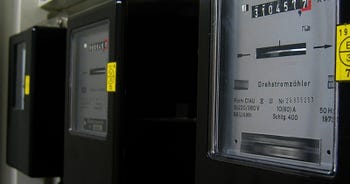What is Energy Management Software?
Smart energy management is as much about business as it is about saving the environment.
And if you could cut business energy bills and protect our planet, why wouldn’t you do both? It’s a win-win situation for any business owner.
Wasting energy is wasting money, and businesses that use energy management software can cut costs by making changes to how they run their business operations.
Curious? Let’s find out how.

30-second Summary
- Businesses that use energy management software can cut costs by making changes to how they run their business operations. The software monitors, tracks and analyses a company's energy usage and makes recommendations for better energy efficiency, cutting energy costs.
- The benefits of an energy management system (EnMS) include visibility on energy usage, lower carbon emissions, better brand reputation and an improved working environment for employees.
- An EnMS can be used by businesses of any size. But every business is different and not all will need the same measuring and tracking abilities. When choosing the right EnMS, business owners should consider who will be using the software, what they want to track, what features they need and if it is compatible with long-term business growth.
- Depending on the outcome of the reports, businesses can changes to improve energy efficiency like removing old or faulty equipment or upgrading to greener technologies which will help save costs in the long run.
What is energy management?
Energy management is the process of monitoring and optimising a company’s energy usage in order to cut down the amount of energy used and reduce costs. It can be done on a scheduled or permanent basis and allows business to cut down their carbon emissions and look after the planet.
Why is energy management important?
Getting to grips with energy management is important for business owners because it helps them get a clear understanding of how they use energy across their business operations. Many companies use a lot more energy than they realise, which is why monitoring and identifying areas of unnecessarily high energy usage is key to making changes and saving businesses money.
Without proper energy management, businesses could be wasting money every year. Faulty appliances, outdated technology and equipment that drinks fuel such as air conditioning units and commercial dishwashers can be costly to run. But, business owners who get on top of any efficiencies make smarter decisions on equipment, processes and business logistics.
What are energy management systems (EnMS)?
An energy management system (EnMS) is a technology designed for businesses to manage their energy usage. It takes a deep dive into existing energy operations and uses smart measurements to identify how the organisation uses energy.
Based on analysis, it then provides valuable insights that can be used to drive improvements to make organisations more energy efficient. This can range from simple things like upgrading to energy-efficient lightbulbs to more complex changes like installing a renewable energy system for self-generated electricity.
How do energy management systems work?
An EnMS can be simple or complex depending on the type of system and what it’s set to measure. But generally, there are key three areas to look for:
Measuring and reporting
- Sensors are normally attached to energy components in a building that measure and record information and send it back to a central unit. For example, information on boiler efficiency, internal temperatures inside a building and humidity levels.
- It then crunches the data and turns it into reports that business owners or stakeholders can digest. For example, it shows energy consumption, emissions, costs and potential savings. And since many businesses use forecasting when budgeting for energy costs, these reports can make decisions much easier.
Monitoring and analysing usage
- Constant monitoring of energy usage helps provide a detailed view over a long period of time. This helps businesses visualise their general energy usage with accurate reports. Ideally, you’ll want to leave an EnMS constantly running so you can track if any improvements are working.
- An EnMS can also send a warning whenever there is a suspicious change in energy usage patterns. You can imagine after several months, you can have a very clear idea of how your business consumes energy, by looking at patterns and the reports provided by the software.
- Some systems allow you to compare your energy usage against baselines or businesses of a similar nature, so you can make a clear comparison. As with most EnMS, you can view all of this within a central, digital dashboard.
Recommendations for efficiencies
- An EnMS is normally linked up to boilers, fans, air conditioning and all sorts of appliances that use energy heavily. When the reports are generated, they include recommendations on how to improve energy efficiency. This makes it easier to make smart changes without only relying on human inspections. For example, in warehouses where temperature control is needed, systems can control shutters to make sure heat is kept in or out during specific times of the day.
What are the benefits of energy management systems?
Lower carbon emissions
With more and more businesses looking to lower their carbon footprint in order to hit our nation’s net zero target, many organisations are creating stricter policies on waste, including energy. Energy management systems can clearly show where energy is being wasted, and provide solutions to reduce it, helping business owners or those in charge to reach the targets set.
Data-driven energy improvements
The data crunched by this type of software gives clear insights, some even creating ‘energy KPIs’ that you can track. The recommendations given are data-driven, helping business owners use numbers to back up any changes needed. This is important if you need to present changes in business infrastructure to stakeholders or change policies in the workplace.
Reduce energy costs
One of the main reasons to go about energy management in the first place is to reduce overall energy costs. After analysing and reviewing reports from an EnMS a company might make the following changes to save money:
- Make improvements to operations - Every so often, the way your business uses energy should be reviewed. Making improvements to equipment, moving equipment, changing processes or adjusting policies around how your business or employees use energy can help cut costs.
- Removing old or faulty equipment - If you’ve been using the same boiler or generator to run your small business for over 20 years, it might not be working as efficiently as it once was. This is normal, sometimes old equipment just needs upgrading or replacing and investing now could save your business in the future.
- Turning everything off at the end of the day - Simple but effective, turning the power off for unused appliances or equipment in your workplace can cut annual energy usage. For example, if you’re running a cafe, then it’s understandable you can’t turn off the power to the fridges when you close. But something as simple as turning off POS systems or asking your employees to switch off plugs can all make a difference. Remember, a little goes a long way!
Encourages sustainability for employees
What if you could create a more efficient workplace and more productive employees? A study by IEEE shows that the productivity of workers increases by 14% when working in a comfortable environment.
Using data from an EnMS with surveys from employees can help to get the balance right. Looking at creating a comfortable temperature, the right lighting and automating processes can help employees get more done during the workday and keep them smiling.
Build a positive brand image
Using software that improves energy efficiency, helps your business go green. Customers and potential employees view brands that care about sustainability in a more positive light than those that don’t. This can help improve your brand perception and encourage more businesses to work with you as well as get more customers in the door. It’s also something you can use in social media marketing materials, but always be careful your efforts are genuine so you avoid greenwashing.
How to choose the right energy management system for your business
There are different organisations offering systems suitable for different energy needs. Not all businesses will need extensive measuring software, or meter tracking, for example.
As a business owner, you may just want to try out using an EnMS first to understand your usage without investing heavily in a complex installation. Companies like Etap, for example, offer industry benchmarking so you can track usage, but without advanced features. This makes it suitable for small businesses who are curious about energy management, but don’t know where to start and don’t want complicated software.
On the other hand, if you have a large business premises or work in an energy-intensive industry, then you might want more advanced technologies to monitor greenhouse emissions, for example. In this case, an EnMS solution, like MRI eSight, offers more features that might be better suited.
To figure out what type of energy system you need, first, you need to nail down the specifics by doing the following:
Know your goals
When looking at types of systems, it’s important to consider what goals you want to achieve with it. Do you want to reduce energy costs? Improve sustainability? Or maybe you want to achieve something specific, like identifying all areas of efficiency, for example. Nailing down what you want to achieve will give you a clearer idea of what type of system is best for your needs.
Consider who will use the EnMS
When considering an EnMS, you’ll want to think about who will be using it. Will it be yourself as a business owner, other stakeholders or a dedicated employee? Knowing who will be using the software will make the choice easier.
If you have an advanced system with in-depth analysis, you’ll want someone who understands how to make the changes suggested to improve your efficiency, but most companies offering this type of software have support lines to help.
Research software features
Once you’ve considered who will use the software, it’s worth comparing the features of EnMS and getting in touch with an organisation as well as contacting companies that offer energy management systems to get introductions or demos of what to expect from the software that’s on the market.
Sites like Capterra offer comparison services for energy management software as a place to start. But if you’re looking at investing in software on a larger scale, then getting in touch with an energy consultant might be a good option.
Choosing for scalability & reliability
When researching and comparing software, you’ll want to consider if you have plans to grow your business as you’ll want to opt for a system that can grow with you. This means it can easily expand if your business grows or technologies change.
What businesses would benefit from an energy management system?
Any business that wants to take a deep dive into energy consumption and make it more efficient can benefit from an energy management system. Even small businesses who want to make simple but effective changes in energy usage can try an EnMS to help them navigate going green. Software varies, and some systems are better suited to medium to large-scale businesses, with multiple premises, multi-meters and complex energy needs, but any business can benefit from it.
For example, Newport City Council identified £30,000 of annual savings by using the energy management software Surple. With a portfolio of several schools, the council needed a way to be notified of high energy usage, so they could communicate solutions to school caretakers. By identifying and fixing maintenance issues quickly with energy management software, they were able to make the local council large savings.
Can an EnMS help in identifying energy-saving opportunities?
Yes, these systems are designed to help pinpoint areas where you can reduce energy waste without interrupting core business operations.
For example, if you own a hair salon or barber shop, then you’ll have a lot of electrical appliances that use a lot of energy throughout the day - hair dryers, clippers, straighteners, as well as heating or air-con units. Using a simple EnMS will be able to help you identify areas where you could make changes to improve energy efficiency, even if they’re small, like turning off the plugs after every use. Making small changes like these all add up to cost savings in the long run.
Save energy costs with Bionic
Want to discover more content on energy? Head over to our energy guides page for a range of topics covering renewables like geothermal energy and commercial heat pumps to understanding your business energy bills, straight from the Bionic team.
And if you need more advice on managing your business energy consumption, or business energy needs, then get in touch with our energy experts today. If you’re coming to the end of your contract or you’re out of contract - we’ll be able to compare deals from our panel of energy suppliers to find competitive rates.
To get in touch, give us a call on 0800 084 6164 or enter your postcode in the box on the right, and we’ll give you a callback.








